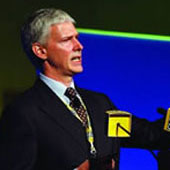Rethinking American Capitalism
Can the United States transform its consumption- and credit-based economy to one based on investment and saving?
October 12, 2012
Capitalism, it is worth recalling, is an economic system in which the private sector drives the economic process through saving, capital accumulation and investment. The government’s role is very limited.
However, contrary to all the rhetoric, the United States has not had that kind of economic system for decades.
Today, the U.S. federal government spends $24 out of every $100 spent in the economy. The U.S. central bank creates the money and manipulates its value. Almost all major U.S. industries are subsidized in one way or another by the government and almost half of all households receive some kind of government assistance.
The economic process itself is no longer driven by saving and investment. Instead, it is driven by credit creation and consumption.
This is not an economic regime that can be called capitalism. Market forces no longer drive the economy. The current system is government-directed, but not planned.
Government policy is determined through a process of compromise between the demands of competing power blocks: big business, the banking industry, the military, the elderly and the general public (which, until recently, had grown to expect an ever-improving standard of living).
Deficit spending and fiat money (i.e., money created by the government) allowed the government to satisfy all those competing demands for more than a generation. During that time, a key component of government policy has been to channel ever-greater quantities of credit to the household sector.
As total credit expanded 50 times in less than 50 years, it created wealth and kept the American Dream alive. That extraordinary expansion of credit changed the nature of the economic system itself, however.
![]()
Outstanding U.S. Credit Market Debt in 2007

Source: U.S. Federal Reserve Flow of Funds
![]()
Capitalism has become Creditism, for lack of a better word. This new credit-based economic system, which requires further credit growth to survive, is now in crisis because the household sector cannot bear any additional debt. The gap between its debt and its income has simply become too great to bear.
The first step toward finding a lasting solution to this crisis is to form a realistic understanding of the nature of this economic system — not as it used to be and not as any particular group thinks it should be, but as it really is. Only then will it be possible to devise a strategy that could correct its faults.
The key question is not whether we are going to abandon capitalism and replace it with a different kind of economic system. We did that long ago. The question is are we going to allow the economic system now in place to collapse.
Investing, not consuming
Thus, this economic crisis marks a crossroad for our civilization. Our options are to grasp and fearlessly exploit the immense possibilities inherent in our new credit-based economic system, or else fail to grasp them and collapse into what could prove to be decades of misery.
To avert economic breakdown, the United States will need to make use of the new policy tools that its new economic system makes possible. Since the private sector cannot bear any more debt, the government sector will have to.
Since the financial crisis began in 2008, U.S. government debt has increased by $5 trillion. It was this increase in government debt that kept the United States — and the world — from collapsing into a new Great Depression.
The world economy is now on government life support and that life support is going to continue. The only question is whether the money will be wasted or spent wisely.
The sustainability of the entire economic superstructure depends on how this debt-financed government spending is used over the years ahead. If it is used for consumption, then it will generate no return and the superstructure will collapse.
The U.S. government must therefore begin spending by investing in large-scale projects that can generate a return. The United States can currently borrow money for ten years at an interest rate of less than 2%. If it borrows at these low rates, invests and earns 3%, the global economic crisis will lessen.
But if it borrows at these low rates and invests aggressively in transformative mega-projects — such as the development of solar energy, genetic engineering, biotechnology and nanotechnology — it might generate such massive returns that the crisis will be overcome and prosperity for the next generation will be assured.
The economic system that has grown out of the adoption of fiat money is new. It is different from what came before. It is not capitalism.
We have not yet learned how it works, and its weaknesses have become glaringly apparent. Yet we are ignoring the possibilities it presents.
What a tragic mistake it would be to impose austerity and see our world implode, when so much credit is available at ultra-low costs. All that is required for us, as a society, is to invest that credit imaginatively in cutting-edge, 21st-century technologies.
If we do that, we can achieve global economic prosperity beyond the dreams of all earlier generations.
Takeaways
The economic process itself is no longer driven by saving and investment. Instead, it is driven by credit creation and consumption.
Market forces no longer drive the economy. The current system is government-directed, but not planned.
For more than a generation, a key component of government policy has been to channel ever-greater quantities of credit to the household sector.
The economic system that grew out of the adoption of fiat money is new. It is different from what came before. It is not capitalism.
Read previous
Protecting the Nanny <s>State</s> Boss
October 11, 2012
